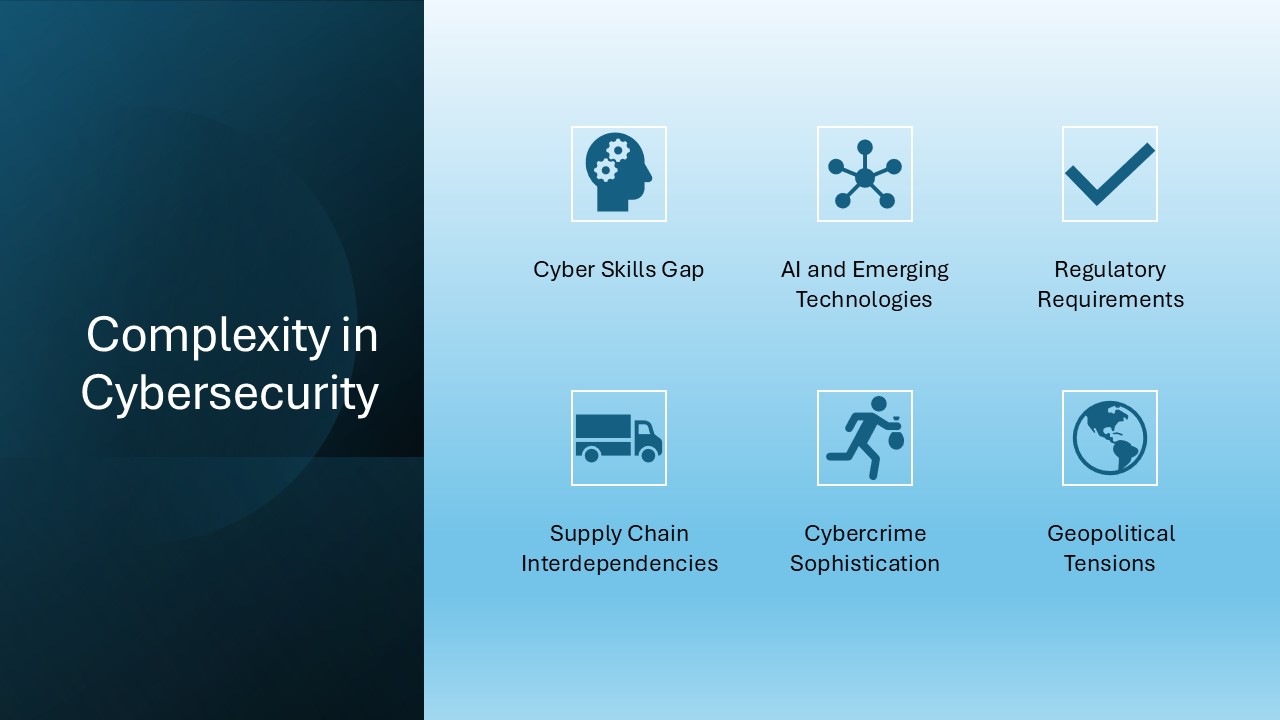As global tensions rise and digital transformation accelerates, state-sponsored cyberattacks have become a central threat to national security, business continuity, and societal stability. In 2025, these attacks are no longer outliers—they're part of a new norm, driven by a confluence of factors compounding the complexity of cybersecurity.
 Figure 1: Factors compounding the complex nature of cybersecurity. (Adapted from Source: Global Cybersecurity Outlook 2025 | World Economic Forum)
Figure 1: Factors compounding the complex nature of cybersecurity. (Adapted from Source: Global Cybersecurity Outlook 2025 | World Economic Forum)
Geopolitical Tensions in Cyberspace
Geopolitical instability is increasingly spilling over into the digital domain. Nation-states are leveraging cyber tools to project power, disrupt rivals, and gain strategic advantages—all without firing a single bullet.
From escalating tensions in Eastern Europe to flashpoints in the Indo-Pacific, cyberspace has become a primary theatre of conflict. These attacks often operate in legal and diplomatic grey zones, making attribution difficult and retaliation diplomatically sensitive.
In 2025, the U.S. has imposed new tariffs on various countries, triggering geopolitical and economic ripple effects that extend beyond supply chains and global markets. At first glance, tariffs may appear to be purely economic and trade-related, but their cybersecurity implications are just as significant.
Trade disputes impact the cost and security of IT supply chains, limit access to cybersecurity tools, and may even lead to retaliatory cyberattacks by nation-state actors.
Complex Supply Chains, Cloudy Risk
Today's digital supply chains are sprawling, interconnected, and indispensable—but they're also incredibly fragile. Modern organisations rely on dozens, if not hundreds, of third-party software and hardware providers. This heavy reliance creates an expanded attack surface, where a single vulnerability in one link can compromise an entire ecosystem. As demonstrated by past incidents like SolarWinds, attackers can lurk undetected within supply chains for months.
In 2025, this risk has grown even more opaque as cloud-native architectures and global outsourcing further reduce companies’ visibility and control over their own systems.
Emerging Technologies Bring New Vulnerabilities
While the adoption of AI, 5G, IoT, and quantum research has revolutionised industries, it has also opened up novel attack vectors for cybercriminals—and more worryingly, for nation-states.
AI-driven attacks are now capable of mimicking human behaviour, evading detection, and launching autonomous campaigns. Quantum computing, though still nascent, is prompting concerns about future-proofing encryption standards. IoT devices remain notoriously under-secured, often acting as soft targets or entry points for lateral movement.
State-sponsored groups are increasingly exploiting these frontiers, using cutting-edge tools to stay several steps ahead of traditional defences.
Regulatory Pressures Add to the Load
To address the rise in cyber incidents, governments worldwide have introduced new regulatory frameworks—ranging from critical infrastructure mandates to cross-border data protection laws.
While well-intentioned, this growing patchwork of international rules poses a significant compliance burden, especially for multinational corporations. Navigating these regulations requires not only legal expertise but constant adjustments to security practices, often with tight deadlines and high stakes. For smaller organisations, the sheer complexity of these requirements can be paralysing.
Skills Gap Widens the Threat Surface
Arguably the most chronic issue compounding all the above challenges is the cybersecurity skills gap. Despite surging demand, there remains a shortage of qualified professionals capable of designing, implementing, and managing robust cyber defences.
This talent shortage is particularly alarming in the face of nation-state-level threats that require rapid detection, strategic thinking, and advanced response capabilities. Many organisations simply lack the human resources to keep pace with the speed and sophistication of modern attackers.
Looking Ahead: From Reaction to Resilience
The escalation of state-sponsored cyberattacks in 2025 is not merely the result of more threats—it is the convergence of interconnected challenges: geopolitical volatility, supply chain opacity, emerging technological vulnerabilities, regulatory overload, and a dwindling cyber workforce.
To navigate this complex threat landscape, organisations need to:
The cyber battlefield is here, and it’s evolving rapidly. State-sponsored attacks will only continue to grow in scale and ambition.
Preparation is no longer optional. It's the new baseline.
BDO Cybersecurity Team has developed a track record over the years by providing cybersecurity services such as incident response, network penetration testing, physical security, application security, and security assessment across various industries. Contact us to learn more about how we can help to better manage and mitigate cybersecurity risks—so you can move forward with peace of mind.
References:
 Figure 1: Factors compounding the complex nature of cybersecurity. (Adapted from Source: Global Cybersecurity Outlook 2025 | World Economic Forum)
Figure 1: Factors compounding the complex nature of cybersecurity. (Adapted from Source: Global Cybersecurity Outlook 2025 | World Economic Forum)Geopolitical Tensions in Cyberspace
Geopolitical instability is increasingly spilling over into the digital domain. Nation-states are leveraging cyber tools to project power, disrupt rivals, and gain strategic advantages—all without firing a single bullet.
From escalating tensions in Eastern Europe to flashpoints in the Indo-Pacific, cyberspace has become a primary theatre of conflict. These attacks often operate in legal and diplomatic grey zones, making attribution difficult and retaliation diplomatically sensitive.
In 2025, the U.S. has imposed new tariffs on various countries, triggering geopolitical and economic ripple effects that extend beyond supply chains and global markets. At first glance, tariffs may appear to be purely economic and trade-related, but their cybersecurity implications are just as significant.
Trade disputes impact the cost and security of IT supply chains, limit access to cybersecurity tools, and may even lead to retaliatory cyberattacks by nation-state actors.
Complex Supply Chains, Cloudy Risk
Today's digital supply chains are sprawling, interconnected, and indispensable—but they're also incredibly fragile. Modern organisations rely on dozens, if not hundreds, of third-party software and hardware providers. This heavy reliance creates an expanded attack surface, where a single vulnerability in one link can compromise an entire ecosystem. As demonstrated by past incidents like SolarWinds, attackers can lurk undetected within supply chains for months.
In 2025, this risk has grown even more opaque as cloud-native architectures and global outsourcing further reduce companies’ visibility and control over their own systems.
Emerging Technologies Bring New Vulnerabilities
While the adoption of AI, 5G, IoT, and quantum research has revolutionised industries, it has also opened up novel attack vectors for cybercriminals—and more worryingly, for nation-states.
AI-driven attacks are now capable of mimicking human behaviour, evading detection, and launching autonomous campaigns. Quantum computing, though still nascent, is prompting concerns about future-proofing encryption standards. IoT devices remain notoriously under-secured, often acting as soft targets or entry points for lateral movement.
State-sponsored groups are increasingly exploiting these frontiers, using cutting-edge tools to stay several steps ahead of traditional defences.
Regulatory Pressures Add to the Load
To address the rise in cyber incidents, governments worldwide have introduced new regulatory frameworks—ranging from critical infrastructure mandates to cross-border data protection laws.
While well-intentioned, this growing patchwork of international rules poses a significant compliance burden, especially for multinational corporations. Navigating these regulations requires not only legal expertise but constant adjustments to security practices, often with tight deadlines and high stakes. For smaller organisations, the sheer complexity of these requirements can be paralysing.
Skills Gap Widens the Threat Surface
Arguably the most chronic issue compounding all the above challenges is the cybersecurity skills gap. Despite surging demand, there remains a shortage of qualified professionals capable of designing, implementing, and managing robust cyber defences.
This talent shortage is particularly alarming in the face of nation-state-level threats that require rapid detection, strategic thinking, and advanced response capabilities. Many organisations simply lack the human resources to keep pace with the speed and sophistication of modern attackers.
Looking Ahead: From Reaction to Resilience
The escalation of state-sponsored cyberattacks in 2025 is not merely the result of more threats—it is the convergence of interconnected challenges: geopolitical volatility, supply chain opacity, emerging technological vulnerabilities, regulatory overload, and a dwindling cyber workforce.
To navigate this complex threat landscape, organisations need to:
- Shift from perimeter defence to zero-trust models
- Invest in threat intelligence and early-warning capabilities
- Foster public-private cybersecurity alliances
- Prioritise workforce development in cyber skills
- Treat cybersecurity as a board-level priority—not just an IT issue
Conclusion
Tariffs and sanctions may aim to protect national interests, but they also risk provoking digital retaliation from adversaries who view cyberspace as the perfect battlefield: one where they can strike hard, stay hidden, and deny everything. When trade talks break down, the silent war online may just be getting started.The cyber battlefield is here, and it’s evolving rapidly. State-sponsored attacks will only continue to grow in scale and ambition.
Preparation is no longer optional. It's the new baseline.
BDO Cybersecurity Team has developed a track record over the years by providing cybersecurity services such as incident response, network penetration testing, physical security, application security, and security assessment across various industries. Contact us to learn more about how we can help to better manage and mitigate cybersecurity risks—so you can move forward with peace of mind.
References:
- Global Cybersecurity Outlook 2025 | World Economic Forum: https://reports.weforum.org/docs/WEF_Global_Cybersecurity_Outlook_2025.pdf
- Defending Against State-Sponsored Cyberattacks in 2025| Zac Amos: https://gca.isa.org/blog/defending-against-state-sponsored-cyberattacks-in-2025
- Trade Wars: How U.S. Tariffs Are Reshaping Cyber Risk and Resilience| Sivesind: https://www.secureworld.io/industry-news/trade-wars-us-tariffs-cyber-risk#:~:text=At%20first%20glance%2C%20tariffs%20seem,cyberattacks%20from%20nation%2Dstate%20actors

